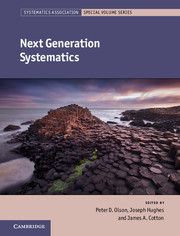Book contents
- Frontmatter
- Contents
- List of contributors
- Introduction: studying diversity in an era of ubiquitous genomics
- Part I Next Generation Phylogenetics
- Part II Next Generation Biodiversity Science
- Part III Next Generation Challenges and Questions
- 10 Perspective: Systematics in the age of genomics
- 11 Perspective: The role of next generation sequencing for integrative approaches in evolutionary biology
- 12 Next generation apomorphy: the ubiquity of taxonomically restricted genes
- 13 Utilizing next generation sequencing for evo-devo study of plant traits
- 14 An NGS approach to archaeobotanical museum specimens as genetic resources in systematics research
- 15 From sequence reads to evolutionary inferences
- Index
- Systematics Association Special Volumes
- Plate section
- References
11 - Perspective: The role of next generation sequencing for integrative approaches in evolutionary biology
from Part III - Next Generation Challenges and Questions
Published online by Cambridge University Press: 05 June 2016
- Frontmatter
- Contents
- List of contributors
- Introduction: studying diversity in an era of ubiquitous genomics
- Part I Next Generation Phylogenetics
- Part II Next Generation Biodiversity Science
- Part III Next Generation Challenges and Questions
- 10 Perspective: Systematics in the age of genomics
- 11 Perspective: The role of next generation sequencing for integrative approaches in evolutionary biology
- 12 Next generation apomorphy: the ubiquity of taxonomically restricted genes
- 13 Utilizing next generation sequencing for evo-devo study of plant traits
- 14 An NGS approach to archaeobotanical museum specimens as genetic resources in systematics research
- 15 From sequence reads to evolutionary inferences
- Index
- Systematics Association Special Volumes
- Plate section
- References
Summary
Introduction
During the last two decades, evolutionary developmental biology (evo-devo) has established itself as an important new branch for the study of evolutionary patterns and processes. Evo-devo can provide insight into the mechanistic changes that result in evolutionary novelty. Besides the many successful applications of evo-devo in animals and plants there is, however, a need for a better integration of evo-devo with population genetics and evolutionary ecology (Sommer 2009). Work at the interface between these disciplines requires an interdisciplinary toolkit and can bring different research traditions closer together. Here, I argue that NGS approaches will play a pivotal role in bridging the different research traditions in contemporary evolutionary biology.
Evolutionary developmental biology: the missing link between development and evolution
Evolution is the change of the heritable characteristics of organisms over time. All biological systems evolve and they do so continuously, making evolution one of the most important properties of biology. The relationship between evolution and the ‘rest of biology’ is twofold: on the one hand, everything in biology has to be considered in the light of evolution (Dobzhansky 1964). On the other hand, our understanding about evolution and the historical processes associated with it depend heavily on the general knowledge available within the biological sciences. Therefore, progress in biology will always affect our understanding of evolutionary patterns and processes.
One recent example that indicates how evolutionary theory depends on progress in the biological sciences is the case of developmental biology. Developmental biology is a classical discipline within biology that has always been at the forefront of research and teaching, simply because all multicellular organisms go through ontogenesis. Until the 1980s, developmental biology was largely a descriptive discipline with a strong focus on cellular and histological mechanisms rather than genes (Amundson 2005). This has changed tremendously with the application of genetic tools and the establishment of selected model organisms. Initiated in the fruit fly Drosophila melanogaster, embryonic development, and in particular segmentation, was dissected with a careful genetic analysis aiming for the identification of genes involved in the segmentation process (Nüsslein-Volhard 1995). Similar unbiased genetic approaches have also been used in the roundworm Caenorhabditis elegans and the flowering plant Arabidopsis thaliana, providing mechanistic insight into various developmental processes, all of which has resulted in textbook knowledge (e.g. Wolpert 2007).
- Type
- Chapter
- Information
- Next Generation Systematics , pp. 229 - 236Publisher: Cambridge University PressPrint publication year: 2016

